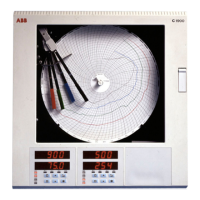21
tUNE
At–tYP
AUtO
StrtUPStrtUP
At SPt
StEP
50
50
0
At
Set point
or
100
0
Start-up
5 CONTROL OPERATION…
Page Header – Auto-tune.
The
key can be programmed to jump to this frame (Set Up Function Keys Page,
ADVANCED CONFIGURATION LEVEL). If the key is used, the display reverts to the first
frame of the
Operating Page on leaving this Page.
Auto-tune Type
The two tuning facilities ('Start-up' and 'At Set point') are used to calculate
automatically the Proportional, Integral and Derivative terms required.
'Start-up' tuning is used from initial start-up or when there is a large change in set
point value.
'At Set point' tuning is used when the process is close to the required set point.
Select the auto-tune type required.
Output Step Size
The output step size is a percentage of the control output.
'Start-up' Tuning – the larger the step size used the quicker the auto-tuning process
is performed, but the greater the overshoot (above the calculated trip point). If too
small a step size is used the response may be too slow for the auto-tuning to operate
correctly. In practice, use as large a step size as can be tolerated.
'At Set Point' Tuning – the controller output changes by plus and minus the output
step size from its initial starting value when auto-tuning is executed. If the output step
size is too large to allow this its value is reduced,
Example – If the controller output value = 30% and the selected step size = 50%. The
step size is reduced to 30%.
The Step size should be large enough so that the amplitude of the process variable
excursions are at least four times larger than the hysteresis parameter to allow the
best possible response data. The output step size must be small enough to avoid
crossing either of the auto-tune limits (see following frames).
Set the step size required.
Continued on next page.
5.7.1 Auto-tuning Page
Information on Initial Conditions.
•'Start-up' Tuning – the controller is placed in the Manual control mode with the control output value set to give a stable
process variable at least 10% of the engineering range below the control set point.
• 'At Set Point' Tuning – may be initialized in the automatic mode but the process variable must be close to the required
set point and stable. The control output must also be stable. However, for best results the Manual control mode can be
used to stabilize the output and the process value. The output must be adjusted slowly to allow process response to the
change, to bring the process variable to the required control set point. The closer the process is to the set point, the more
effective the auto-tuning cycle.

